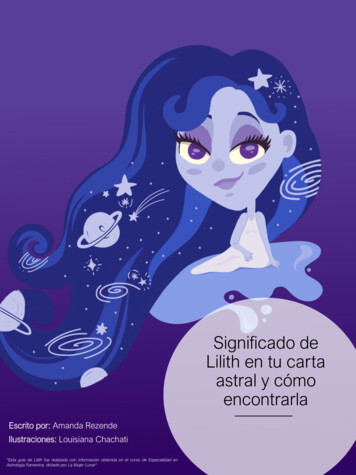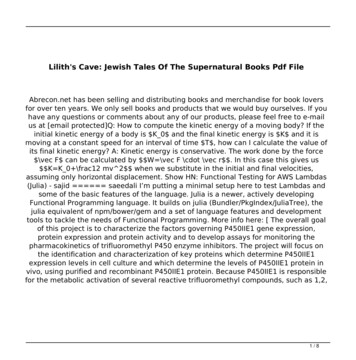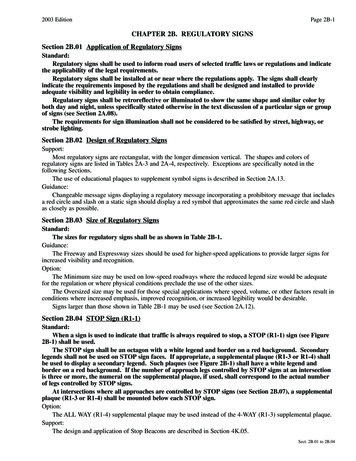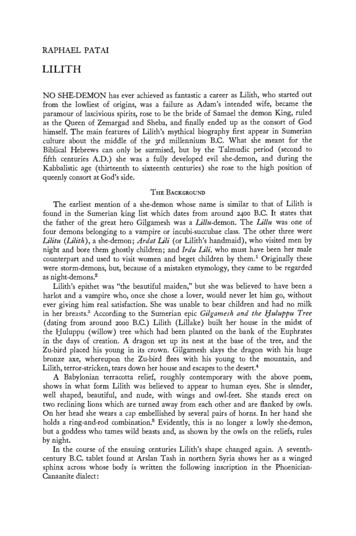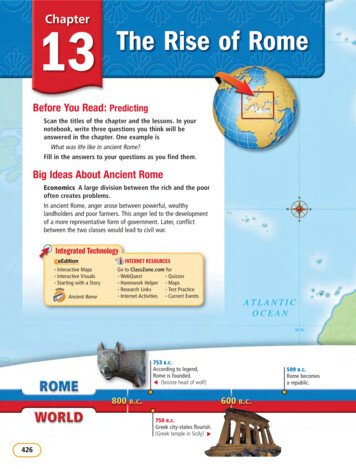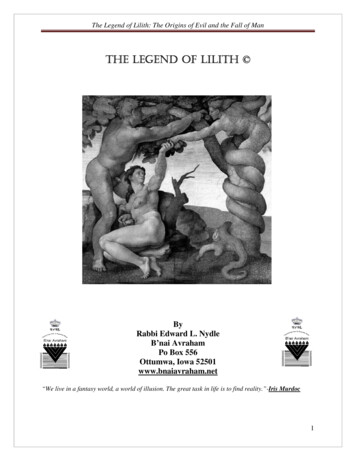
Transcription
The Legend of Lilith: The Origins of Evil and the Fall of ManTHE LEGEND OF LILITH ByRabbi Edward L. NydleB’nai AvrahamPo Box 556Ottumwa, IA 52501www.bnaiavraham.netByRabbi Edward L. NydleB’nai AvrahamPo Box 556Ottumwa, Iowa 52501www.bnaiavraham.net“We live in a fantasy world, a world of illusion. The great task in life is to find reality.”-Iris Murdoc1
The Legend of Lilith: The Origins of Evil and the Fall of ManTABLE OF CONTENTSAuthor’s Introduction:Chapter 1: Religion: Eyes Wide ShutChapter 2: Lost in TranslationChapter 3: Origins of EvilChapter 4: All in the FamilyChapter 5: The Nature of EvilChapter 6: Break on Through to the other sideChapter 7: The Gates of EdenChapter 8: Adam before the fallChapter 9: Please allow me to introduce myselfChapter 10: The Harlot, Bride, and QueenChapter 11: Adam Raised a CainChapter 12: After the FloodChapter 13: Just Like a WomanChapter 14:Don’t Lose Your HeadChapter 15: Weapons of Mass DeceptionChapter 16: Encounters of the Third KindChapter 17: Lilith and JungChapter 18: Symbolic MeaningsAppendix:Supplemental Reading:2
The Legend of Lilith: The Origins of Evil and the Fall of Man34:14 And the wild-cats shall meetYeshayahuwith the jackals, and the satyr shall cry to1his fellow2; yea, the night-monster ( tylyl )3shall repose there4, and shall find her a place ofrest.51BDB Definition: 1) hairy (adjective) 2) he-goat, buck (noun masculine) 2a) as sacrificial animal 2b) satyr, mayrefer to a demon possessed goat like the swine of Gadara (Mat 8:30-32). In Greek mythology the satyrs are deitiesof the woods and mountains. They are half human and half beast; they usually have a goat's tail, flanks, and hooves.While the upper part of the body is that of a human, they also have the horns of a goat. They are the companions ofDionysus, the Elohim of wine, and they spent their time drinking, dancing, and chasing nymphs. The Italian versionof the satyr is the faun, while the Slavic version is the Ljeschi. One of the most famous Satyrs was Pan, a son ofHermes and a nymph. He was the Elohim of green fields and the guardian of the shepherds. He is also associatedwith the worship of Dionysus. They have assumed the archetypal qualities of challenging sexual repression according to George Orwell in his book “The Clergyman’s Daughter” in which the heroine found that sort of thing distasteful after witnessing ‘certain scenes’ between her father and mother as a child.2Strongs # 7453 From H7462; an associate (more or less close): - brother, companion, fellow, friend, husband, lover, neighbor, (an-) other.3The Jewish Study Bible correctly translates this verse: Wildcats shall meet hyenas, Goat-demons shall greet eachother; There too the Lilith shall repose and find herself a resting place. YLT: And met have Ziim with Aiim andthe goat for its companion calleth, only there rested hath the night-owl, and hath found for herself a place ofrest.4The verses describe a state of desolation, due, in the context, to the destruction of Jerusalem by the Babylonians in587 BCE. YHWH is angry both at the destruction of the place and the exile of the people from it; the verses are alsosupposed to reflect that this desolation is brought on themselves by people who worshipped other deities. We knowthat this part of the Scriptures was written by the scribes in exile at that time and put together later, as an object lesson in what happens to those (many,) people who did not adhere to the patriarchal monotheism that was the religionof the ruling classes. The word in Hebrew which is translated by (night) hag is Lilith. It is the only time in the Scriptures that the word Lilith appears. The translation night hag comes from Revised Standard Version (reasonablymodern and said to be very accurate). The more familiar King James Scriptures (Authorized Version) translatesLilith as "screech owl". A look at other Scriptures translations shows that New English Scriptures (NEB) givesnight-jar. The Revised Version (RV) of 1881 uses night monster; the Latin Vulgate of the 4th century CE fromwhich most Christian translations stem says Lamia - who are the Hellenistic "dirty Goddesses'. Moffat (American)produces "vampires" (plural), French Scriptures calls Lilith "le specter de la nuit" (ghost of the night), and GermanLutheran translates her as der Kobold - masculine - a sprite or goblin. None of them give her real name, Lilith. Perhaps they are afraid to use it. The patriarchal world turned Lilith into a monster, strangling new born babies andsucking their blood; a demoness howling in the desert and in the night, making men impotent, causing cattle to dieand generally being the personification of evil. In medieval times, the church called her Mother of the Witches, andprojected on to women all these feared so-called attributes of Lilith. Christians united with Jews and Moslems intheir fear of her.3
The Legend of Lilith: The Origins of Evil and the Fall of ManAUTHOR’S INTRODUCTIONWhat we call the beginning is often the end, and to make an end is to make a beginning. The end is wherewe start from. The end of all our exploring will be to arrive where we start and know the place for thefirst time. T.S. ElliotCowardice asks the question - is it safe? Expediency asks the question - is it politic? Vanity asks the question - is it popular? But conscience asks the question - is it right? And there comes a time when one musttake a position that is neither safe, nor politic nor popular; but one must take it because it is right.-DrMartin Luther King, Jr"Those who danced were thought to be quite insane by those who could not hear the music."-Angela MonetThe origins of evil are the same as the root causes of all mankind’s problems: ignorance, prejudice,apathy, hatred, envy, jealousy, and greed which arise from within man because of his yetzer harah(evil inclination). Evil arises from ignorance about YHWH’s6 instructions, ethics and morals, a lack ofsympathy, compassion, and empathy for your neighbor, and lusting after more than one deserves andneeds. Evil is manifest through the behavior of man, but yet it exists beyond the realm of actions; it existsin the heart and mind of every man and woman. As long as mankind exists, you will find the evil inclination (yetzer harah) within him. It is a matter of man’s free choice and exercising the gift of free will.7Life is simply about increasing the level of Light in the world by tearing away the veils that create darkness. There are two principles in life: Light and darkness. Darkness comes in various shades and Lightcomes in countless colors. At the center of everything is either Light or darkness. Our emotions, state ofmind, consciousness, and every event in our lives are merely manifestations of either the Light or darkness that we have invited into our lives. These negative or positive emotions and events are the effect andthe Light or darkness is the Cause.Good things happen in this physical world when we somehow connect with the unseen world of Light.When things go wrong in this physical world it means we have disconnected from the World of Light.When the unseen World of Light and the physical world meet, they combine to create 100 % reality.8Evil is not some Biblical hocus pocus nonsense nor is it represented by a horned man in red long underwear carrying a pitchfork. Evil is a malicious tyrant who is ethically bankrupt with no sense of decency ormercy. Evil is a heinous oppressor who through fear and division causes ruin, injury and pain, in order tosecure his or her social, economic, religious, and political dominance. Evil is the infamous source of suf-5The Interpreter's Scriptures only comments on certain verses of Yeshayahu’s chapter 34. They are 1-6, 8-11, 14etc. The comment for chapter 14 says: The demons of popular superstition, including Lilith, the storm demon ornight hag, which haunt ruins and waste places, have taken possession of the former homes of men.6The Four Letter name of the Hebrew Elohim –h v h y7Free will is simple the choice of the soul to receive or not receive. Satan represents the force of the desire to onlyreceive for self.8The unseen world of Light makes up 99% of reality and this physical world (Malkhut) makes up only 1%.Together they equal 100%.4
The Legend of Lilith: The Origins of Evil and the Fall of Manfering, misfortune and destruction of mankind. There is only one approach to confront and eradicate evil;that is by shining the Light on them and their actions, revealing their true motivations and evil character.The building blocks of evil in society are: greed, envy, racial and religious prejudices, ignorance, greed,bigotry, elitism, individualism, greed, poverty, conducive social and economic conditions, in which thevalue of humankind is replaced with commercial profits and the Almighty Dollar9, where the public isconstantly bombarded with divisive messages of fear, hate, and violence, ranging from violent sportingevents resembling the ancient Greek/Roman games to fearful violent news and fearful, hateful violententertainment on television and the movies. These are the infectious germs that spread the virus of cruelty and hate among mankind. Cruelty is possible only when people do not recognize in one another theimage of the Creator that is the essence of their own being-hence they turn away from others; do not heartheir cries of pain. This powerful force is then spread and transferred from one generation to another. 10 “Human misery is more often caused not so much by stupidity as by ignorance, particularly ourown ignorance about ourselves.” Carl SaganTo recognize if any given society has been infested and taken over by evil is not that difficult, just lookaround. We have all been distorted since early childhood. The non-recognition of others is the source ofpain and anger. We need to ask ourselves the question, “Are we our brother’s keeper?” The minute werecognize the “other” then we can recognize our obligation toward mutual concern. Preventing and eradicating evil is actually very easy. It begins with a simple self-examination, followed by self-correction andultimately self-realization. Change begins within you! Evil is not some inevitability that must be accepted,but a distortion that must be combated. Allowing the distortions and evil of the past prevents us from addressing the distortions and evil of the present.The Eternal One, according to the account in Bereshith (Genesis), looked at the world, “and behold, itwas very good-ve’hineh-tov me’od” (Genesis 1:31). The distortions, the evil, the cruelty, class structures,imperialism, murder, war, rape, the anger and hatred- these are not built into the fundamental structure ofthe true reality. The concepts of love, peace, justice, equality, healing, and transformation are not for“heaven”, but are for this physical world. This is the true message of the prophets to mankind and theworld in general. The message was directed to daily life, to the family, marketplace, and to the state. Religion used to cover up economic immorality was an affront to YHWH.9Yahshua called it “Mammon”. It is Mishnaic Hebrew and Aramaic for "riches." The word itself is given in theSermon on the Mount. "Ye cannot serve Elohim and mammon" (Matt. 6: 24). There is no evidence that there was aSyriac Elohim of this name, the modern idea that such a Elohim existed being derived from Milton's personificationof the name—"Mammon, the least erected spirit that fell from heaven" ("Paradise Lost," i. 679). The word occurs inAvot ii. 12, where almsgiving is called "the salt of mammon or riches." Gesenius suggests that the word was derivedfrom "maṭmon" ("treasure"), with assimilation of the "ṭet." The spelling with three "m's," however, is apparently notjustified; the Greek form with two is held by most scholars to be correct. In the Bible, "mammon" is not a demon butsimply an Aramaic word meaning "wealth" or "property." Originally, the word Mammon came from the ancientChaldean and actually has its roots in the word 'confidence.' At its most basic level, the word meant 'riches' or'wealth,' but it connoted an idea of personified wealth gained with avarice. It often took on a deified nature. In theMiddle Ages, Mammon gained the full-on demon status. Many local bishops and feudal lords benefited from the fearand trembling that peasants felt about gaining worldly wealth.10List of deaths attributed to genocide (all figures are in millions): Crusades 1.5; Slave trade 18, Native Americandecimation 20; Jewish Holocaust 6; Tibetan Genocide 1.2; Balkan Genocide 1.5; Vietnam, Cambodia, Laos 2.2. Inthe 20th century 80 million lives were lost to violence based in ethnic, religious, and philosophical conflicts – that is5 times more than lives lost due to natural disasters and AIDS.5
The Legend of Lilith: The Origins of Evil and the Fall of ManWhen the collective psyche of a nation is weakened because of a lack of resolve of its members, socialcohesion will break down. This psychological confusion and mental illness that afflicts individuals, begins to afflict the nation as a whole. When this occurs, a nation acts insane or as one possessed with anunclean spirit. This is a recipe for disaster and destruction to that nation, as other nations will prey upontheir weakened state and conquer them from without or within.The Torah is in the form of a book but it not a book. It is not a written text but a living text. Concealedwithin it is a living soul, a consciousness. It is alive; it is aware; it knows itself and its Creator, and itknows mankind. The Torah cannot be read like a book, as that only disguises its real intent. One has to gobehind the written text of the Torah and find its hidden secrets, as these are the paths to contacting its living essence. Then it will speak to you and you will hear the voice of the Torah, the inner voice of yourconsciousness, in the secret place where the conscious mind unites with the unconscious.Torah was given to create a stable and sane society and community. Torah is all about life in this worldand how life in other spiritual planes interacts with us here. Everything revolves around us here and now.Its instructions are not an end in itself. Torah was given to be a channel to bring about sanity, security,and stability to a nation, and the whole planet. The mitzvoth act as connections that bring heaven to earthand elevate the earth to the Heavens. Thus, our proper actions create a stability society. This results inphysical and psychological security, which enables our minds to give thanks to the Heavens.The commandments of the Torah are about social relations. True spirituality is not just about findingsome private truth, but about creating a world community that reflects and embodies the spiritual truthswe learn. The health of the human soul requires involvements in a community that is itself committed tohealing and transforming the social and political world even as it provides the means of healing and transforming individuals.The Torah commandments are also expressions of scientific universal principles. When the mitzvoth areobserved properly influences are created and there are subtle shifts in cosmic energies that affect the human consciousness and the environment. Knowing the meaning of a mitzvah is different than knowingwhat to do at the proper time. The commandments serve as archetypes that enable our true human essencereconnect with our higher self (the neshamah) or higher dimensional Source.The Torah commandments also assist us in calibrating our collective consciousness to the higher vibration of the alternate realities. When one observes the Torah, a transformation occurs within one psychologically, or one could say they become a new person within .Change has to come from within. This canonly occur when one’s external behavior is in harmony with the Creator. Change seldom arises independently from within; there is something we must do. Actions change the attitude, not the other way around.Mankind cannot be remorseful concerning its behavior as long as we continue our improper behavior. Wehave to consciously choose good over evil, right over wrong, and justice over injustice. The process oftikkun (rectification) means not only to stop creating damage, but repairing the damage we have createdby our actions and words.Torah speaks the language of the human soul. It tells us how to reconnect our hearts, souls, and minds tothe Source. The mitzvoth contain universal truths. They are metaphors, but rather scientific formulas forthe transformation of the consciousness that enable us to evolve. It is the human heart that gets confusedand misguided. When the heart is led astray, the higher human consciousness gets disconnected from theSource (the higher mind), and we become trapped on earth, exiled, and lost from our original Source6
The Legend of Lilith: The Origins of Evil and the Fall of ManThese ritual commandments have nothing to do with religion. Religion is an exercise of the mind. It is thestudy and practice of theology. Theology is a form of philosophy. Both are only mental gymnastics thattry to explain the reality of the finite world around us. Torah is not limited to these immature pursuits.Torah transcends the mind as it does this physical universe. So observing the mitzvoth should not becalled being religious; it should be called natural and at times supernatural. They are what make us humans created in the image of Elohim. One does not have to be religious to observe the Torah. Religion ismore about politics, money, culture, and ethnicity, than it is about true Torah observance. Mankind needsto be less religious and more Torah observant. Torah was not given to start a new religion. Religion doesnot exist in the Scriptures nor in the original Hebrew. Religion imprisons the mind and stops the spiritualevolution of the human soul. One has to make their personal exodus from psychological slavery into psychological freedom by passing over into a conscious embracing of the truth revealed in the Torah.The old understanding of being “commanded” was of commandments handed down from a mountain,but today any sense of commandment must come from within, from inside us. Doing a “mitzvah” is aworshipful act. This action puts us into a higher level of dialogue with the universe. We act out of the desire to communicate with the Holy One we have felt. Thus, as our practice deepens, our relationship withthe Creator grows more intimate. Each mitzvah consecrates us to Elohim.Religionists and philosophers have pondered the origins of evil for thousands of years, and yet they stillhave not arrived at a single consensus about what evil really is. The lack of clarity from Scriptural scholars defaults the ethical field to the world’s religions, traditions, politics, and ideologies. Most peoplelearn their ethics and morals from their parents, peers, church, and community. Indoctrinated in this matrix since birth, most people think that their cultural, religious, political, and personal views and opinionsare absolute and universal truths. They then seek to make their doctrines and beliefs universal by force,revolutions, reformations, and wars. We can know which ethic is the moral imperative for humanity if weapply wisdom, understanding, and knowledge (Chochmah, Binah, and Da’at). Yet this beginning point,even reason, is rejected by most of the world. They believe that their religious and political views are theonly truth because they came from their personal g-d and religious tradition. Their beliefs are ingrained totheir very core, and no amount of logic, reason, and evidence will shake their convictions that they alonehold the keys to all truth.Reasoning begins with premises that come from observation. We can observe that there nothing in human nature that makes one race of people masters over another set who are slaves. The moral default istherefore always equality among men. As recognized by John Locke and Thomas Jefferson, human beings are created as equals, with an equal moral worth, because human beings use reason in making choices in the pursuit of their goals.Our independent thinking and feeling, and the equal status of our subjective values, create a universalethic by which all acts which coercively harm others are evil. Harm consists of an invasion into one’sdomain, so if one is merely disgruntled with what others do, the offense is not a harm and not evil by theuniversal ethic. But those who believe only their own cultural ethic believe that offensive acts, such as thepractice of other religious beliefs or traditions, are evil and should be punished and destroyed. And then inpunishing the offense, the perpetrator commits the real evil by imposing himself as master, declaring thathis culture, government, economics, and religion are superior, and the other is inferior and evil.7
The Legend of Lilith: The Origins of Evil and the Fall of ManThe essence of evil is ignorantly greedy supremacy: imposing one’s subjective will on non-harmful human action. Evil takes place because the evil doers are ignorant of the universal ethic and because theylack love and compassion for their victims. The greatest evil seems to always come from the pursuit ofthe “greater good.” Nazis, Communists, and Socialists, traditionalists, religious supremacists, right wingconservative traditionalists all believe in their greater good and seek to impose it by force if necessary, notrealizing that this use of force is the real evil.The cognitive independence and moral equality of human beings makes all our values individually subjective, and therefore the concept of the “greater good” is fallacious. There cannot be any “greater good”but only the goods that individuals are interested in and personally value. To avoid evil, it is not enoughto intellectually understand that it is morally wrong to coercively harm others. One must also be instilledwith sympathy and compassion for others, an empathy that dissolves greed and makes it hurtful to oneselfto inflict harm on others.Good is just not the absence of evil - increasing the good in the world and in your life requires youractive participation and action. A person can achieve this goal by living their life in a way that recognizes the tenets of true spirituality, and by working to live a life with courage, compassion and criticalthought.There are two basic reasons why people commit evil. Some people are simply amoral. They lack sympathy and do not think there is any morality. To them their victims are merely animals. They think, if someone is weak or foolish enough to be a victim, they deserve no better than to be destroyed because of theirweakness.But most evil is committed by people who believe they are doing what is good. In most wars today, theattackers think they are serving the greater good of all mankind. If innocent people are killed, the attackers think that the victims are not really innocent, but guilty by association, and secondly, the bad of killingis more than offset by the greater good of the goal of their religion or government. In effect, these attackers make themselves the judge over others, assuming a superior position as master, judge, and executor.The avoidance of evil therefore requires that a person not make himself the supreme judge and jury overothers. Except in immediate defense against impending harm, justice requires an institutional process andobedience to the laws of Elohim. If everybody attacks every person who allegedly did bad, or is bad byassociation, we end up with chaos, as in today’s world.Unfortunately, few people are open to logical arguments over ethics. The indoctrination of religion, politics, and culture is so deep that very few people can overcome being imprisoned by those institutions andthe strongholds built in their minds. This is why evil has persisted since the beginning.Since the beginning of recorded history men have lusted for control of their fellows—the impulse seemingly part of the makeup of the half-animal, half-angel we call human. Until modern times brute force,propaganda, and religion were the most successful methods for the manipulation of human beings, but bythe turn of this century coercive methodology had advanced far beyond the sword, the inflammatory slogan and the stick and carrot of heaven and hell.1111The idea of Heaven and Hell as places where the good are rewarded and the evil punished after they die comes notfrom the Scriptures but from Plato. Here, from the Republic (c. 400 BCE), is the relevant part of Plato's myth of Er.After the reward or punishment described below, the souls are reincarnated. This myth is the foundation for Purgatory, for fiery devils as tormentors of the damned, and for the idea that people go up into the sky after they die. Thetraditional concept of Hell does NOT come from the inspired Hebrew or Greek manuscripts. It is a pagan myth8
The Legend of Lilith: The Origins of Evil and the Fall of Manadopted as Christian doctrine in the third century by church fathers. Yet, then as now, innocent people are taught thetraditional concept of Hell by trusted authority figures. That trust deters questions, so for hundreds of years themyth has perpetuated. The KJV and other translations have also perpetuated the myth by less than the most accuratetranslation of the word Hell. Where did the concept of eternal torture (punishing) come from? It is apparent theycome to us from early teachings of the Roman Catholic Church. From the Encyclopedia Americana: "The mainfeatures of hell as conceived by Hindu, Persian, Egyptian, Grecian, and Christian theologians are essentially thesame. The Western religious from Roman times through the Middle Ages borrowed the doctrine of eternal torturefrom the Pagan Philosophers. Certain writers of the Middle Ages had such tremendous influence on the Christianprofessing world, that their writings and teachings came to be generally accepted and believed, until it became thedoctrine of the Christian-professing world. Among these influential writers were Augustine and Dante Alighieri"Thomas Nelson Page describes in his 1923 book "Dante and His Influence" that Dante was not the first to conceiveof a journey into the Infernal regions:"Homer and Virgil had both pictured in immortal verse such an experienceand other poets had done the same"."But he [Dante] was the first to make such a journey the central thread onwhich to hang in epic form the whole of Human Life together with the conditions that brought it into being,"."Allthe preaching of the time was of a material or physical Inferno and Purgatory. None doubted the existence, or evenwithin limits the location of such places of punishment. Many Ages have passed since then without substantialchange of this fundamental idea, and up to a generation or two ago, it may be said to have been generally accepted,and even now is distinctly taught by a great portion of the body of the Church" Again from the Encyclopedia Americana:"Virgil, pagan Roman poet, 70-19 B.C. belonged to the national school of pagan Roman thought, influencedby the Greek writers. Christians of the Middle Ages, including Dante, believed he had received some measure ofdivine inspiration" Plato was a pagan Greek philosopher, born in Athens, 427 B.C.E., a student of Socrates also apagan. The traditional concept of sinners tormented for all eternity in a fiery hell is clearly from the imaginations ofPAGANS. Yahshua referred to "Gehenna," the valley of Hinnom, where garbage burned continually, corpses weresometimes deposited, and in earlier times, people had been sacrificed. He only referred to it to illustrate his lessonsabout spiritual growth and the earthly realm--that the earthly body was meaningless and would be thrown on thegarbage dump. Some suggest he was warning Yisrael that it must turn away from its earthly focus and reform bybeing more concerned with spiritual growth and the inner person, and if it didn't, the Jews would be destroyed infire. He was right, of course. Jerusalem and the temple were torched in 70 CE. He didn't refer to a hell as everlastingtorment. By the time of the first English translations of the Renewed Testament, the hell myth had been so wellrooted in church tradition that where the translators saw "Gehenna," they simply inserted "hell" as the translation.That led to the misconception about hell being in the Renewed Testament and in Yahshua's teaching. (From TheOrigin and History of the Doctrine of Endless Punishment by Thomas B. Thayer, 1855) “The word hell, in theOld Testament, is always a translation of the Hebrew word Sheol, which occurs sixty-four times, and is rendered"hell" thirty-two times, "grave" twenty-nine times, and "pit" three times. By examination of the Hebrew Scriptures itwill be found that its radical or primary meaning is the place or state of the dead. It is plain that it has here no reference to a place of endless torment after death. It is plain, then, from these citations that the word Sheol, "hell,"makes nothing for the doctrine of future unending punishment as a part of the Law penalties. It is never used byMoses or the Prophets in the sense of a place of torment after death; and in no way conflicts with the statement already proved, that the Law of Moses deals wholly in temporal rewards and punishments. Now no one believes insuch a hell as this. A material hell of fire, and torments by flame, have been long ago abandoned. And the Saviorcannot be understood as believing or teaching future torments, . . . We have now passed in review, as far as ourlimits will permit, the New Testament doctrine of hell, and we have not, surely, found it to be the doctrine of endlesspunishment, but something very wide from this.” CHAPMAN. [Mark Chapman, Oxford theologian and historian]"Sheol, in itself considered, has no connection with future punishment." Cited by Balfour, First Inquiry. DR. ALLEN says: "The term Sheol does not seem to mea
The Legend of Lilith: The Origins of Evil and the Fall of Man 3 eshayahu 34:14 And the wild-cats shall meet with the jackals, and the satyr 1 shall cry to his fellow 2; yea, the night-monster ( tylyl )3333 shall repose there 4, and shall find her a place of rest. 5 1 BDB Definition: 1) hairy (adjective) 2) he-goat, buck (noun masculine) 2a) as sacrificial animal 2b) satyr, may


